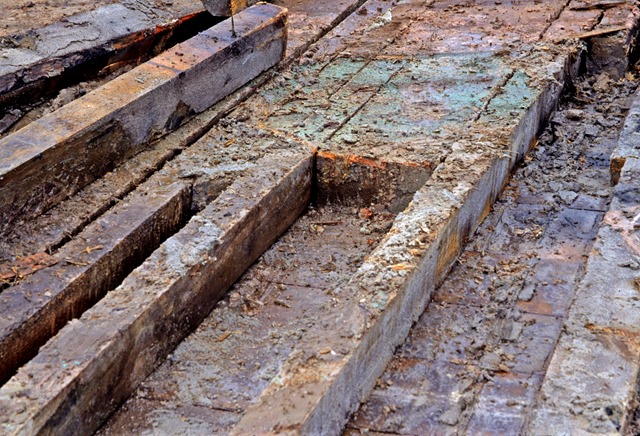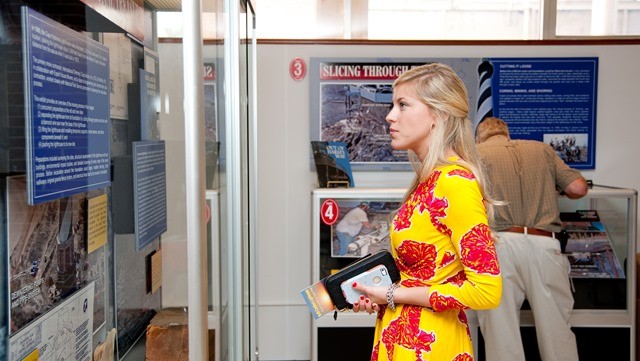The Cape Hatteras Lighthouse, the tallest brick lighthouse in the country, has long been considered a national treasure. Originally 1500 feet from the breaking waves, the ocean advanced to within a mere 120 feet over the course of more than a century. Construction of this impressive structure just after the Civil War, on a rugged barrier island, is an engineering feat. But it is the 1999 moving of the lighthouse, to evade the encroaching sea, that provides an inspiring civil engineering case-study complete with controversy, engineering, science, and history.
NCSU, including the Department of CCEE, was intimately involved in the “Move of the Millennium.” In the summer of 1999 anxious crowds, alongside television and newspaper reporters, watched apprehensively over the 23 days it took to safely edge the lighthouse, freed from its foundation, along a steel runway 2900 feet to its new home. The nearly 200 foot tall lighthouse is one of the ten heaviest buildings ever moved, weighing in at almost 5,000 tons. It has no internal structural supports, and had been battered by 129 years of hurricanes and beach erosion. Many citizens opposed the move, convinced that it would end in catastrophic loss of the lighthouse.
A museum-quality display created for the lobby of Mann Hall contains artifacts and photographs to introduce visitors and students to this fascinating success story that encompasses so many disciplines including structural, geotechnical, construction, environmental and coastal engineering.
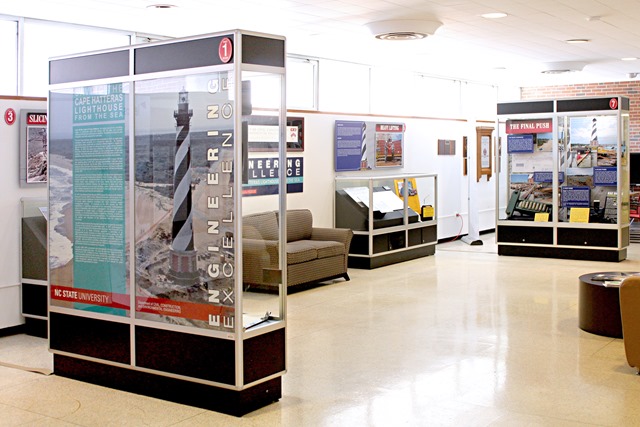
“Engineering Excellence: Saving Cape Hatteras Lighthouse from the Sea” was dedicated on April 27, 2015 with an enthusiastic gathering of many key players from the 1999 move, as well as the designers and creators of the new display.
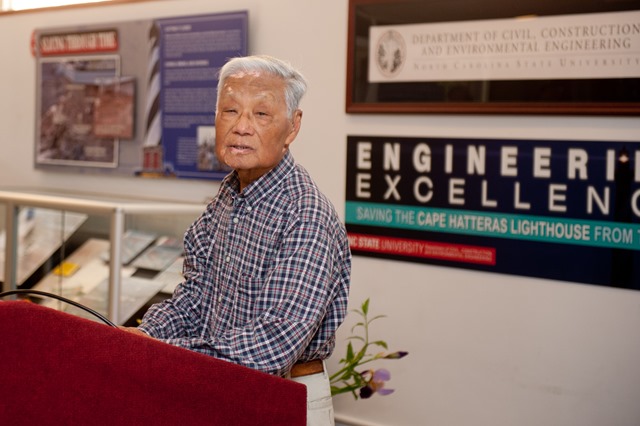
Dr. Paul Zia, Distinguished University Professor Emeritus of Civil Engineering and Alumni Distinguished Graduate Professor Emeritus, along with Dr. Ellis B. Cowling, Distinguished Professor At-Large Emeritus of Forestry and Plant Pathology, served on an interdisciplinary team from the National Academy of Sciences (NAS) called upon in 1986 to advise the National Park Service (NPS). In a 1988 report the committee, which included engineers, scientists, historians and construction experts, recommended relocation after carefully studying a myriad of options. However, nearly a decade passed with no action.
In 1996 NCSU issued its own report, co-authored by Zia, that endorsed the original NAS findings. When funding was finally secured in 1998, Dr. Zia was again called upon, this time to evaluate contractor’s bids.
In 1999 Dr. Paul Zia, and Dr. Ellis Cowling received the NPS Citizen’s Award for Exceptional Service for their role as advisors and consultants. Dr. Zia smiles when he relays that part of his award included a hardhat, and part of Dr. Cowling’s award included a piece of one of the original yellow pine timbers that were part of the foundation. Upon retirement, in 2013 Dr. Cowling began looking for a home for the piece of timber he had proudly displayed in his campus office. It was this artifact that spurred the idea for the current exhibit.
Department Chair Morton Barlaz and Dr. Zia worked closely with John Havel to write and design the exhibit. Presently a graphic designer with the U.S. Environmental Protection Agency, John spent ten years designing exhibits with the NC Museum of History and is authoring a book about North Carolina lighthouses. Mike Booher, the official photographer during the 1999 move, graciously provided numerous photographs. Jake Rhoads, CCEE Facilities Maintenance Technician, assisted with the construction of the design cases and the mounting of large artifacts such as the Hilman roller. During the final phase of the move 100 Hilman rollers, fitted with guides and each paired to a hydraulic jack, were used to move the lighthouse along steel beams.
We invite our readers to visit and view this great new addition to Mann Hall!
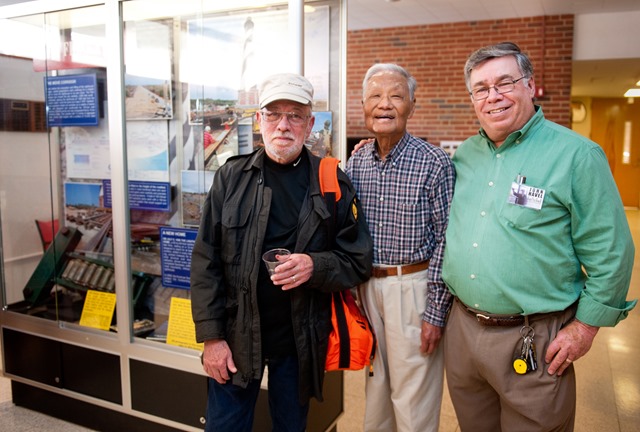
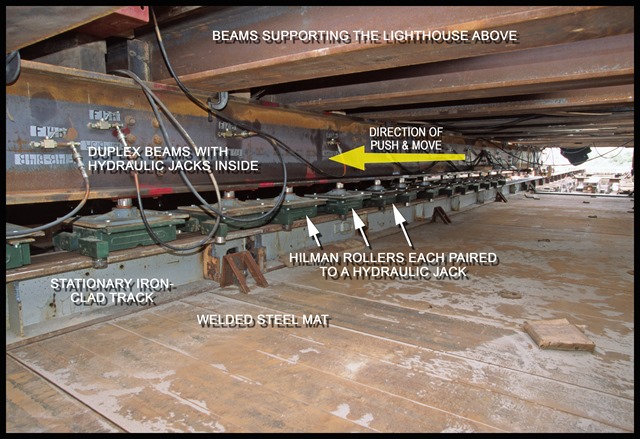
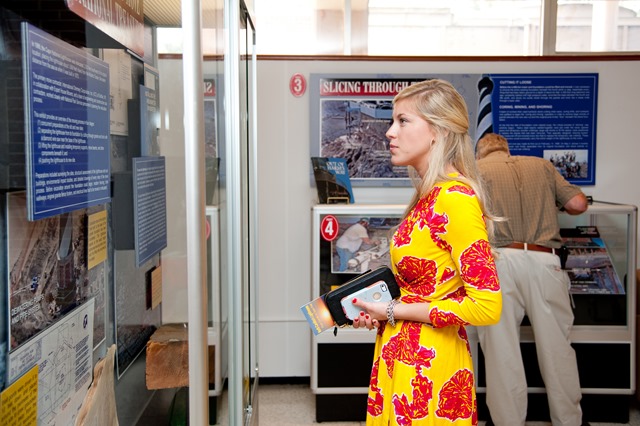
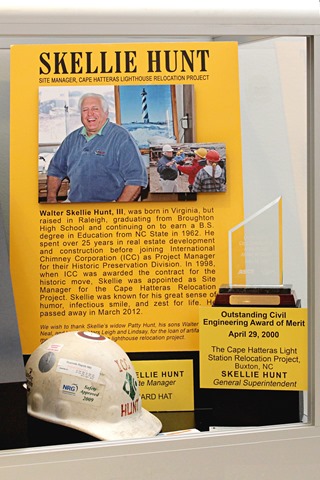
Just after the end of the Civil War, the Lighthouse Board hired Dexter Stetson to construct the third Cape Hatteras Lighthouse. Conditions were difficult and his crew labored long hours under the southern sun, battling mosquitoes on what was at the time a very remote, sparsely populated island. It was impossible to drive pilings into the compacted sand as the structural drawings called for. Instead he dug a six- foot hole, pumped out the fresh water that filled it, then laid layers of yellow pine timbers, which he knew would never rot as long as they stay submerged in the fresh water. Dr. Paul Zia says “The science did not even exist at this time for him to understand why the pine would not rot, but he knew it. The science would come later.”
When the National Park Service completed the move of the Cape Hatteras Lighthouse in 1999, the 131-year old timbers were indeed still in immaculate condition. Visitors can view a piece of the timbers in the new exhibit in Mann Hall lobby.
